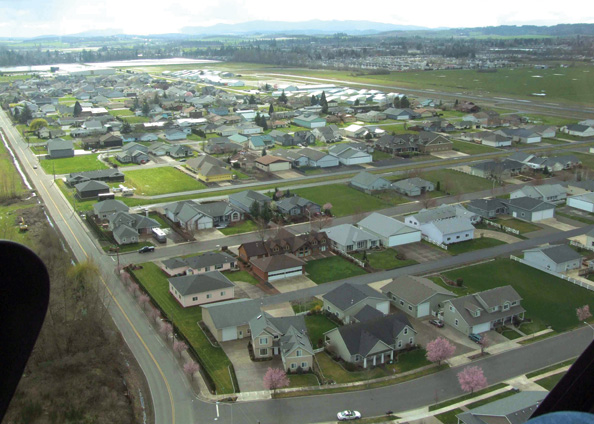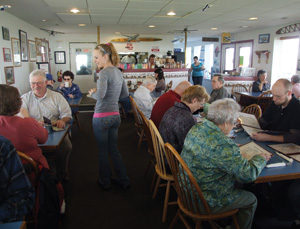
For many years, exhibitors at large airshows have promoted a dream that some of us have pursued: living at a residential airpark with houses, adjoining or attached hangars and runway access. Of the more than 200 airparks in the country, most are at privately owned airports. The FAA has no beef with these. But at approximately 47 publicly owned, FAA-funded airports, the Feds have recently adopted a new hardball version of a 1989 policy that frowned on but did not prohibit public airport sponsors (cities, counties, states, port districts) from negotiating through-the-fence (TTF) access agreements with residential airparks.
The new document, FAA Order 5190.6B, takes a less accommodating tone. Worse, a draft of the associated compliance letter says in bold type and underlined, There are no acceptable forms of TTF agreements [at residential airparks]. The FAAs stand is policy, not law; no federal air regulation (FAR) addresses this issue. But the new document would appear to abrogate a 2009 letter from a manager in the FAAs Northwest Mountain Region office specifically approving Oregons TTF agreement with the large airpark where I live.
Why should other general aviation pilots care? Because properly structured residential airparks-especially at public airports-can provide a vital buffer that protects the airport from encroachment by non-aviation interests.
Whats the Problem?
The FAAs official concern is based on threats to federally funded airports when nearby residents complain about aircraft noise. The concern is legitimate where ordinary housing tracts surround formerly rural airports. But at residential airparks, where homeowners have moved long distances and invested life savings specifically to participate in an airport environment, the FAA stance defies logic. These people like airplane noise!
By the FAAs own admission, the noise complaint reasoning lacks evidence. A Wyoming physician with an airpark lot at a threatened airport used the Freedom of Information Act (FOIA) to request documents relating to such complaints at TTF airparks. The FAAs eventual response: No such documents could be found.
Security? Nobody steals an airplane from off-airport private hangars. And airpark homes along the airport boundary provide a free, 24-hour measure of security for the airport itself.
Safety? At a properly structured residential airpark, street and taxiway traffic do not mix. Nobody has cited safety as a serious issue.
Fairness? Some in the FAA have noted verbally that TTF agreements substantially increase airpark home values. What is not mentioned is that airpark residents willingly pay airport access fees (plus higher initial purchase costs and steeper property taxes). Contrast this with transient daytime fly-in visitors, who generally pay nothing for their access to these public airports.
A threat to airport business? Large TTF airparks are often the only reason that businesses at these small airports survive. The FAAs new policy is a classic case of a solution looking for an elusive problem. A case in point follows.

The airports Starduster Cafe benefits from a steady stream of airpark residents, others from the city and transient pilots.
How to Do It Right
Research turned up a surprising fact: The residential airpark where I live, alongside Independence (Oregon) State Airport (7S5), may be the largest airpark at a publicly funded airport in the country. Its one of the most successful for the airport owner (the state of Oregon) and for its host city and county (through airpark residents community involvement and significant property taxes).
Begun in 1968, 7S5 has the only paved runway in the county. Its two FBOs, a maintenance facility and the airport restaurant are supported largely by airpark residents. EAA Chapter 292, one of the most active in the country, owns a large facility on leased airport land. Most members live at the airpark.
With the approval of the FAA and the state aeronautics division (now the Oregon Department of Aviation-ODA), the airpark was begun in the mid-1970s on the east side of the airport. It now consists of 10 dead-end streets with the cul-de-sacs at the west end near the airport boundary. Taxiways with the knobs at the east end are behind the 182 houses and 31 remaining lots; car and aircraft traffic cannot mix. Airpark taxiways are owned and maintained by the airpark associations.
Each lot owner, regardless of whether the lot has a house or an aircraft or neither, pays the state an annual rate equal to a years tiedown fees. The homeowner associations (there are two) collect the fees and forward them to the state. The CC&Rs, which are enforceable by lien under state law, permanently enjoin airpark residents from complaining about aircraft noise. Every house is required to have either a hangar or a paved tiedown space. Hangars are required to match their houses, using the same siding, paint color, roof materials and window styles. The place looks attractive.
The airpark entry and exit taxiways also accommodate on-airport hangars, so the access costs the FAA and the state nothing. Closing airpark access would devastate the community, strand more than 200 aircraft (and there are no nearby airports that could hangar them), and cost the state more than $30,000 annually. Of Oregons 28 state-owned airports, including the 12 that receive FAA funds, only four operate in the black; 7S5 is one of the four.
The Solution
As an airpark homeowner and a member of the board of the larger homeowner association, Im not a neutral party in this fray. At the request of the city council, I briefed members on the situation, summarizing with these words:
Recommended action: That affected parties petition the FAA to abandon its blanket one-size-fits-all residential TTF prohibition and encourage residential airparks at appropriate locations with properly executed agreements. FAA should recognize that residential airparks can be the most effective protection and support a small airport can have. This position is shared by ODA, the Oregon Aviation Board, AOPA, EAA and the Oregon Pilots Association.
The council voted unanimously to oppose the new TTF policy, and the mayor wrote a strong letter to the FAA. Since then, Oregons two U.S. senators and our U.S. congressman have sent the FAA a joint letter asking for justification of the new policy.
In my personal letter to the FAA, I concluded like this:
If the FAA prevails in its attempt to close access, many aviation families will sell their homes for what they can get, and new residents without aviation interests may eventually pressure airport closure because they don’t like aircraft noise. At that point, the FAA objection to any type of residential community next to an airport becomes an FAA-caused, self-fulfilling prophecy. The only threat to the continued excellent health of 7S5 is the FAAs through-the-fence access policy.
What is needed is a change to national FAA policy, not just a local reprieve. We will see what happens.

![]()
Dave Martin served as editor of this magazine for 17 years and began aviation journalism evaluating ultralights in the early 80s. A former CFI (airplanes, gliders, instruments), hes flown more than 160 aircraft types plus 60 ultralights (including a single-seat, no-basket hot air balloon). Now living at a residential airpark in Oregon, he flies his new Vans Aircraft RV-12.




